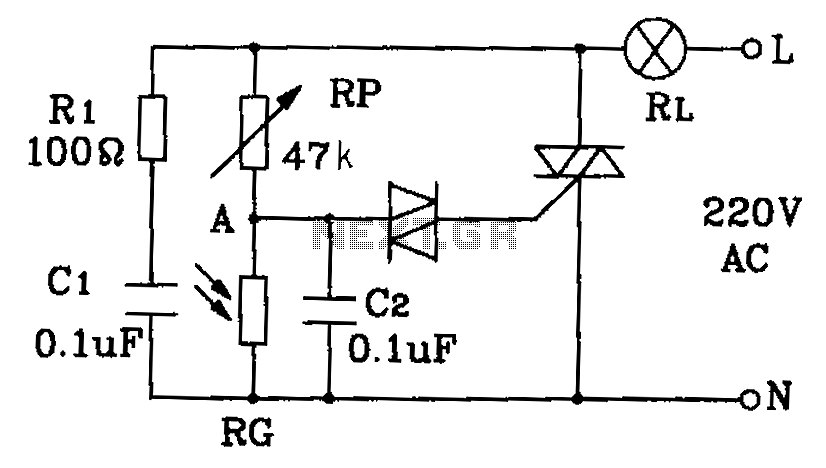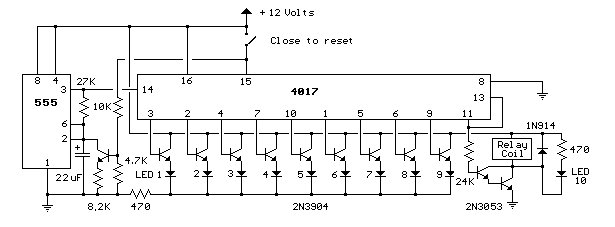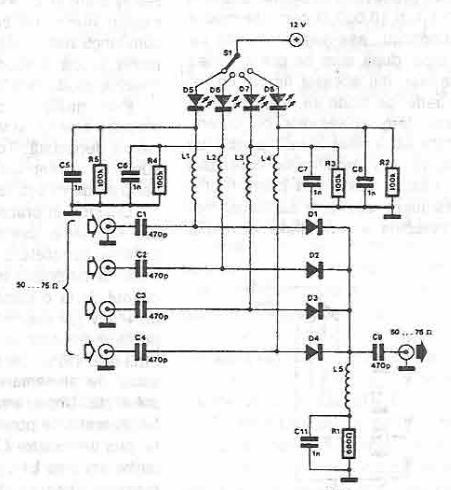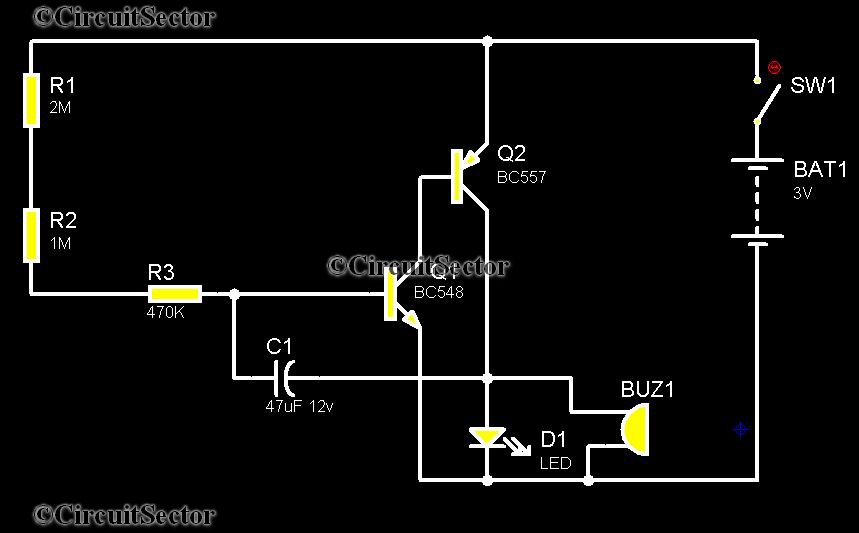
Infra-red detector circuit
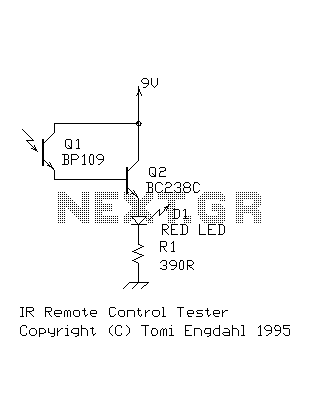
This circuit is a simple IR detector for testing IR remote controllers. The circuit is based on one phototransistor which receives the IR beam. The NPN transistor works as an amplifier which feeds current to the LED. When this circuit detects IR or light, the LED is on. So you need to shield the phototransistor from ambient light if you don't want to do your tests in the dark. The best way is to fit the phototransistor in a small black tube. I used a 2 cm long piece of insulating tube and fitted the phototransistor into the middle of the tube. More: Brief description of operation: Detects IR signals from TV remote controllers Circuit protection: No special protection needed Circuit complexity: Very simple and easy to build, no need for circuit board Circuit performance: Not very good, detects IR remote controller signals nicely at 10 cm distance, also sensitive to normal light and can't be used on bright light to detect IR remote controller signals Availability of components: Original components might not be available everywhere, suitable components for modifications Design testing: Built quickly from the parts found in my lab, the first prototype was usable, few different photosensitive transistors tried Applications: IR remote controller testing, detecting IR beam, testing of phototransistors Power supply voltage: 9V battery Power supply current: less than 1 mA in darkness, up to nearly 20 mA in bright light Component cost: Few dollars. If you own a video camera you can use it directly for viewing the IR signal from the remote control. Just point the remote control to the video camera and you should see some flickering light in the video screen/viewfinder. This works because the CCD elements in the modern video cameras are also sensitive to IR radiation. This idea works with most of the video cameras but might fail on some (because some older cameras did not use CCD elements and some new video cameras can have very good IR filtering in them).
One day, it was suggested that any AM radio could be used to detect the signals the IR remote controller sends. Testing a small AM radio tuned to the 530-1800 KHz band with several IR remote controllers confirmed this idea. When the IR remote controller is placed near the radio and pointed at the ferrite antenna of the AM radio, bleeping sounds can be heard when the remote control is activated. The AM radio does not detect the actual IR beam but rather the electrical noise generated by the IR remote controller during operation.
Almost any common NPN small signal transistor should work as Q2. If BC238 is not available, BC547 or 2N2222 can also be used. For Q1, nearly any phototransistor can be utilized, though performance may vary. The noise detected by the AM radio may stem from high current pulses sent to the IR LED during transmission or from RFI generated by the controller IC within the IR remote controller. The reason the AM radio picks up these signals effectively may be due to the fact that IR remote controllers typically use a 455 KHz ceramic crystal resonator as part of their frequency synthesis circuit. This frequency aligns with the intermediate frequency (IF) for AM receivers. The remote generates a carrier wave around 40 KHz, modulated with square waves typically ranging from 400 µs to 800 µs. This modulation can be heard as an audio tone between 1-3 kHz on a radio tuned anywhere within the AM band.This circuit is a simple IR detector for testing IR remote controllers. The circuit is based on one phototransistor which receives the IR beam. The NPN transistor works as an amplifier which feeds current to the led. When this circuit detects IR or light, the LED is on. So you need to shield the phototransistor from ambient light if you don't want to do your tests in the dark. The best way is to fit the phototransistor in a small black tube. I used 2 cm long piece of insulating tube and fitted the phototransistor into the middle of the tube.
Brief description of operation: Detects IR signals from TV remote controllers Circuit protection: No special protection needed Circuit complexity: Very simple and easy to build, no need for circuit board Circuit performance: Not very good, detects IR remote controller signals nicely at 10 cm distance, also sensitive also to normal light and can't be used on bright light to detect IR remote controller signals Availability of components: Original components might not be available everywhere, suitable components for modificantions Design testing: Built quickly from the parts found on my lab, the first prototype was usable, few different photosensitive transistors tried Applications: IR remote controller testing, detecting IR beam, testing of phototransistors Power supply voltage: 9V battery Power supply current: less than 1 mA on darkness, up to nearly 20 mA on bright light Component cost: Few dollars. If you own a video camera you can use it directly for viewing the IR signal from the remote control. Just point the remote control to the video camera and you sould see some flickering light in the video screen/viewfinder.
This works because the CCD elements in the modern video cameras are also sensitive to IR radiation also. This ideas works with most of the video cameras but might fail on some (because some older cameras did not use CCD element and some new video cameras can have very good IR filtering in them).
I one day received a mail telling that you can also use any AM radio to detech the signals the IR remote controller sends. I tested a small AM radio (tuned to 530..1800 KHz band) with half dozen IR remote controllers and this idea really works.
When you put the IR remote controller near the radio and point your IR remote control at the ferrite antenna of an AM radio, you should hear bleeping sounds from the radio when you activate the remote control. The AM radio does not detect the actual IR beam, but it will detect the electrical noise the IR remote controller generates when it operates.
Almost any common NPN small signal transistor should work as Q2. If BC238 is not available BC547 or 2N2222 should work also. If you can not find original component model for Q1 you cna try almost any phototransistor for this (the circuit performance might vary but should work somehow with wide variety of phototransistors). I think that nose noises are form high current pulses sent to the IR LED when it transmits or the RFI from the controller IC inside the IR remote controller.
The reason why AM radio picks up those well might be that IR remote controllers used in consumer products typically uses 455KHz ceramic crystal resonator as part of frequency synthesis circuit. 455KHz happens to be IF for the AM receivers. Remote generates about 40Khz carrier modulated with typically around 400uS-800uS square wave. You should be able to hear this square wave as between 1-3 kHz audio tone on radio tuned at anywhere in the AM band.
🔗 External reference
One day, it was suggested that any AM radio could be used to detect the signals the IR remote controller sends. Testing a small AM radio tuned to the 530-1800 KHz band with several IR remote controllers confirmed this idea. When the IR remote controller is placed near the radio and pointed at the ferrite antenna of the AM radio, bleeping sounds can be heard when the remote control is activated. The AM radio does not detect the actual IR beam but rather the electrical noise generated by the IR remote controller during operation.
Almost any common NPN small signal transistor should work as Q2. If BC238 is not available, BC547 or 2N2222 can also be used. For Q1, nearly any phototransistor can be utilized, though performance may vary. The noise detected by the AM radio may stem from high current pulses sent to the IR LED during transmission or from RFI generated by the controller IC within the IR remote controller. The reason the AM radio picks up these signals effectively may be due to the fact that IR remote controllers typically use a 455 KHz ceramic crystal resonator as part of their frequency synthesis circuit. This frequency aligns with the intermediate frequency (IF) for AM receivers. The remote generates a carrier wave around 40 KHz, modulated with square waves typically ranging from 400 µs to 800 µs. This modulation can be heard as an audio tone between 1-3 kHz on a radio tuned anywhere within the AM band.This circuit is a simple IR detector for testing IR remote controllers. The circuit is based on one phototransistor which receives the IR beam. The NPN transistor works as an amplifier which feeds current to the led. When this circuit detects IR or light, the LED is on. So you need to shield the phototransistor from ambient light if you don't want to do your tests in the dark. The best way is to fit the phototransistor in a small black tube. I used 2 cm long piece of insulating tube and fitted the phototransistor into the middle of the tube.
Brief description of operation: Detects IR signals from TV remote controllers Circuit protection: No special protection needed Circuit complexity: Very simple and easy to build, no need for circuit board Circuit performance: Not very good, detects IR remote controller signals nicely at 10 cm distance, also sensitive also to normal light and can't be used on bright light to detect IR remote controller signals Availability of components: Original components might not be available everywhere, suitable components for modificantions Design testing: Built quickly from the parts found on my lab, the first prototype was usable, few different photosensitive transistors tried Applications: IR remote controller testing, detecting IR beam, testing of phototransistors Power supply voltage: 9V battery Power supply current: less than 1 mA on darkness, up to nearly 20 mA on bright light Component cost: Few dollars. If you own a video camera you can use it directly for viewing the IR signal from the remote control. Just point the remote control to the video camera and you sould see some flickering light in the video screen/viewfinder.
This works because the CCD elements in the modern video cameras are also sensitive to IR radiation also. This ideas works with most of the video cameras but might fail on some (because some older cameras did not use CCD element and some new video cameras can have very good IR filtering in them).
I one day received a mail telling that you can also use any AM radio to detech the signals the IR remote controller sends. I tested a small AM radio (tuned to 530..1800 KHz band) with half dozen IR remote controllers and this idea really works.
When you put the IR remote controller near the radio and point your IR remote control at the ferrite antenna of an AM radio, you should hear bleeping sounds from the radio when you activate the remote control. The AM radio does not detect the actual IR beam, but it will detect the electrical noise the IR remote controller generates when it operates.
Almost any common NPN small signal transistor should work as Q2. If BC238 is not available BC547 or 2N2222 should work also. If you can not find original component model for Q1 you cna try almost any phototransistor for this (the circuit performance might vary but should work somehow with wide variety of phototransistors). I think that nose noises are form high current pulses sent to the IR LED when it transmits or the RFI from the controller IC inside the IR remote controller.
The reason why AM radio picks up those well might be that IR remote controllers used in consumer products typically uses 455KHz ceramic crystal resonator as part of frequency synthesis circuit. 455KHz happens to be IF for the AM receivers. Remote generates about 40Khz carrier modulated with typically around 400uS-800uS square wave. You should be able to hear this square wave as between 1-3 kHz audio tone on radio tuned at anywhere in the AM band.
🔗 External reference
Warning: include(partials/cookie-banner.php): Failed to open stream: Permission denied in /var/www/html/nextgr/view-circuit.php on line 713
Warning: include(): Failed opening 'partials/cookie-banner.php' for inclusion (include_path='.:/usr/share/php') in /var/www/html/nextgr/view-circuit.php on line 713

